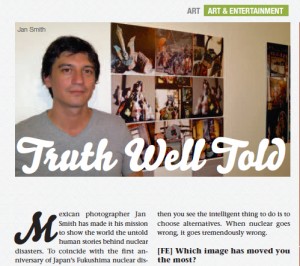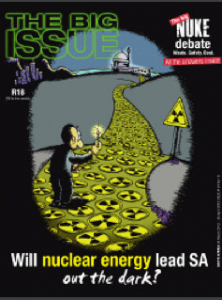A Truth Well Told ART ART & ENTERTAINMENT 30 MARCH – 20 APRIL 12 .THE BIG ISSUE. 35.
 Mexican photographer Jan Smith made it his mission to show the world the untold human stories behind nuclear disasters. To coincide with the first anniversary of Japan’s Fukushima nuclear disaster in March, Smith brought his Nuclear Disaster Stories exhibition to Cape Town in partnership with the Koeberg Alert Alliance. Smith’s debut exhibition in South Africa included a world-first release of images taken in Fukushima in February. by Fem Eggers
Mexican photographer Jan Smith made it his mission to show the world the untold human stories behind nuclear disasters. To coincide with the first anniversary of Japan’s Fukushima nuclear disaster in March, Smith brought his Nuclear Disaster Stories exhibition to Cape Town in partnership with the Koeberg Alert Alliance. Smith’s debut exhibition in South Africa included a world-first release of images taken in Fukushima in February. by Fem Eggers
Truth Well Told: [Fem Eggers] What drew you to this project?
[Jan Smith] In 2009, I was invited to do a photo essay on Chernobyl. Though abandoned places had long intrigued me in my work, I had not considered Chernobyl before. I went to Pripyat [the city created in 1970 to house workers from the Chernobyl Nuclear Power Plant in the Ukraine] which has remained abandoned since the nuclear disaster in 1986. While there I realized there is so much more to tell than stories about radiation and cancer. I took photos at a nursery where everything was pretty much left untouched, as it had been 25 years ago; storybooks, toys, notebooks. That made it very personal for me. After that I wanted to tell people’s stories.
Truth Well Told: [FE] What do you hope to achieve?
[JS] The project is all about creating awareness around alternatives to nuclear energy. I see this as a civic duty. I was never an activist, but once you have looked at the numbers, at what happens when it goes wrong, then you see the intelligent thing to do is to choose alternatives. When nuclear goes wrong, it goes tremendously wrong.
Truth Well Told: [FE] Which image has moved you the most?
 [JS] A photo of the remnants of the Hina Matsuri Festival [Japanese Doll Festival, or Girls’ Day] in Japan, where people traditionally display dolls in their houses. The festival took place one week before the tsunami and subsequent nuclear disaster in Fukushima, and in some abandoned homes the dolls are still laid out. When I went into Fukushima I didn’t know about the festival at first, so when I found a doll I thought, ‘That’s interesting’. Then I found a second doll and thought it was coincidence. When I found the third doll, I knew I was onto something; it became sort of a mystery. To me, though, it’s not just evidence left behind — it’s a part of the personal stories of the victims and survivors of that disaster that was overlooked or forgotten.
[JS] A photo of the remnants of the Hina Matsuri Festival [Japanese Doll Festival, or Girls’ Day] in Japan, where people traditionally display dolls in their houses. The festival took place one week before the tsunami and subsequent nuclear disaster in Fukushima, and in some abandoned homes the dolls are still laid out. When I went into Fukushima I didn’t know about the festival at first, so when I found a doll I thought, ‘That’s interesting’. Then I found a second doll and thought it was coincidence. When I found the third doll, I knew I was onto something; it became sort of a mystery. To me, though, it’s not just evidence left behind — it’s a part of the personal stories of the victims and survivors of that disaster that was overlooked or forgotten.
Truth Well Told: [FE] How would you respond to criticism that you are ‘sensationalizing’ nuclear disasters?
[JS] I don’t think I am sensationalising at all. Most nuclear-related photography focuses on deformities and cancer caused by radiation. I take a more aesthetic and historical— even archaeological — angle. I want to draw people in and show them that the human stories go so much deeper than radiation.
*Jan Smith’s Nuclear Disaster Stories exhibition in Cape Town has now closed, but you can view his work at www.smithjan.com
Truth Well Told: ART ART & ENTERTAINMENT 30 MARCH – 20 APRIL 12 .THE BIG ISSUE. 35
